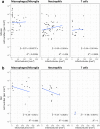Immune Cell Infiltration into the Brain After Ischemic Stroke in Humans Compared to Mice and Rats: a Systematic Review and Meta-Analysis
- PMID: 33496918
- PMCID: PMC8557159
- DOI: 10.1007/s12975-021-00887-4
Immune Cell Infiltration into the Brain After Ischemic Stroke in Humans Compared to Mice and Rats: a Systematic Review and Meta-Analysis
Abstract
Although several studies have suggested that anti-inflammatory strategies reduce secondary infarct growth in animal stroke models, clinical studies have not yet demonstrated a clear benefit of immune modulation in patients. Potential reasons include systematic differences of post-ischemic neuroinflammation between humans and rodents. We here performed a systematic review and meta-analysis to summarize and compare the spatial and temporal distribution of immune cell infiltration in human and rodent stroke. Data on spatiotemporal distribution of immune cells (T cells, macrophages, and neutrophils) and infarct volume were extracted. Data from all rodent studies were pooled by means of a random-effect meta-analysis. Overall, 20 human and 188 rodent stroke studies were included in our analyses. In both patients and rodents, the infiltration of macrophages and neutrophils preceded the lymphocytic influx. Macrophages and neutrophils were the predominant immune cells within 72 h after infarction. Although highly heterogeneously across studies, the temporal profile of the poststroke immune response was comparable between patients and rodents. In rodent stroke, the extent of the immune cell infiltration depended on the duration and location of vessel occlusion and on the species. The density of infiltrating immune cells correlated with the infarct volume. In summary, we provide the first systematic analysis and comparison of human and rodent post-ischemic neuroinflammation. Our data suggest that the inflammatory response in rodent stroke models is comparable to that in patients with stroke. However, the overall heterogeneity of the post-ischemic immune response might contribute to the translational failure in stroke research.
Keywords: Immune cell infiltration; Inflammation; Ischemic stroke; Meta-analysis.
© 2021. The Author(s).
Conflict of interest statement
HW: honoraria for Scientific Advisory Boards Biogen, Evgen, Genzyme, MedDay Pharmaceuticals, Merck Serono, Novartis, Roche Pharma AG, and Sanofi-Aventis. Speaker honoraria and travel support from Alexion, Biogen, Cognomed, F. Hoffmann-La Roche Ltd., Gemeinnützige Hertie-Stiftung, Merck Serono, Novartis, Roche Pharma AG, Genzyme, TEVA, and WebMD Global. Paid consultant for Abbvie, Actelion, Biogen, IGES, Johnson & Johnson, Novartis, Roche, Sanofi-Aventis, and the Swiss Multiple Sclerosis Society. Research is funded by RE Children’s Foundation, Biogen, GlaxoSmithKline GmbH, Roche Pharma AG, Sanofi-Genzyme.
LK: Compensation for Scientific Advisory Boards for Alexion, Genzyme, Janssen, Merck Serono, Novartis and Roche. Speaker honoraria and travel support from Bayer, Biogen, Genzyme, Grifols, Merck Serono, Novartis, Roche, Santhera and Teva. Research support from Biogen, Novartis and Merck Serono.
CJS and WRS are inventors on the patent application “Hematopoietic factors for treatment of neurological condition” including stroke. Recently a part of the application (ALS) was granted. CJS and WRS transferred their rights to Sygnis and received a minor financial compensation upfront. In case of efficacy CJS and WRS participate in form of royalties. WRS: Compensation as PI of the AXIS I study.
SM: Speaker honoraria and travel support from Almirall, Amicus Therapeutics Germany, Bayer Health Care, Biogen, Celgene, Diamed, Genzyme, MedDay Pharmaceuticals, Merck Serono, Novartis, Novo Nordisk, ONO Pharma, Roche, Sanofi-Aventis, Chugai Pharma, QuintilesIMS und Teva. Research is funded by Almirall, Amicus Therapeutics Germany, Biogen, Diamed, Fresenius Medical Care, Genzyme, HERZ Burgdorf, Merck Serono, Novartis, ONO Pharma, Roche, and Teva.
JM: Grants from EVER Pharma Jena GmbH, and Ferrer International, travel grants from Boehringer Ingelheim, and speaking fees from Bayer Vital and Chugai Pharma.
CB, RR, JKS, ASP, HM, and TR declare no conflict of interest.
Figures




Similar articles
-
Impact of hydroxytyrosol on stroke: tracking therapy response on neuroinflammation and cerebrovascular parameters using PET-MR imaging and on functional outcomes.Theranostics. 2021 Feb 15;11(9):4030-4049. doi: 10.7150/thno.48110. eCollection 2021. Theranostics. 2021. PMID: 33754046 Free PMC article.
-
Brain-Derived Microparticles (BDMPs) Contribute to Neuroinflammation and Lactadherin Reduces BDMP Induced Neuroinflammation and Improves Outcome After Stroke.Front Immunol. 2019 Nov 26;10:2747. doi: 10.3389/fimmu.2019.02747. eCollection 2019. Front Immunol. 2019. PMID: 31993045 Free PMC article.
-
Interleukin-19 alleviates brain injury by anti-inflammatory effects in a mice model of focal cerebral ischemia.Brain Res. 2016 Nov 1;1650:172-177. doi: 10.1016/j.brainres.2016.09.006. Epub 2016 Sep 5. Brain Res. 2016. PMID: 27608956
-
Statin Therapy in Ischemic Stroke Models: A Meta-Analysis.Transl Stroke Res. 2020 Aug;11(4):590-600. doi: 10.1007/s12975-019-00750-7. Epub 2019 Dec 2. Transl Stroke Res. 2020. PMID: 31788761 Review.
-
Exosome therapies improve outcome in rodents with ischemic stroke; meta-analysis.Brain Res. 2023 Mar 15;1803:148228. doi: 10.1016/j.brainres.2022.148228. Epub 2022 Dec 30. Brain Res. 2023. PMID: 36592803 Review.
Cited by
-
X-ray fluorescence mapping of brain tissue reveals the profound extent of trace element dysregulation in stroke pathophysiology.Metallomics. 2024 Dec 2;16(12):mfae054. doi: 10.1093/mtomcs/mfae054. Metallomics. 2024. PMID: 39547935 Free PMC article.
-
Detrimental influence of Arginase-1 in infiltrating macrophages on poststroke functional recovery and inflammatory milieu.Proc Natl Acad Sci U S A. 2025 Feb 18;122(7):e2413484122. doi: 10.1073/pnas.2413484122. Epub 2025 Feb 14. Proc Natl Acad Sci U S A. 2025. PMID: 39951507 Free PMC article.
-
A minimally invasive thrombotic model to study stroke in awake mice.Nat Commun. 2025 May 10;16(1):4356. doi: 10.1038/s41467-025-59617-1. Nat Commun. 2025. PMID: 40348793 Free PMC article.
-
Neuronal Serpina3n is an endogenous protector against blood brain barrier damage following cerebral ischemic stroke.J Cereb Blood Flow Metab. 2023 Feb;43(2):241-257. doi: 10.1177/0271678X221113897. Epub 2022 Dec 1. J Cereb Blood Flow Metab. 2023. PMID: 36457151 Free PMC article.
-
Optimising the photothrombotic model of stroke in the C57BI/6 and FVB/N strains of mouse.Sci Rep. 2022 May 9;12(1):7598. doi: 10.1038/s41598-022-11793-6. Sci Rep. 2022. PMID: 35534531 Free PMC article.
References
-
- Powers WJ, Rabinstein AA, Ackerson T, Adeoye OM, Bambakidis NC, Becker K, Biller J, Brown M, Demaerschalk BM, Hoh B, Jauch EC. 2018 guidelines for the early management of patients with acute ischemic stroke: a guideline for healthcare professionals from the American Heart Association/American Stroke Association. Stroke. 2018;49(3):e46–99. - PubMed
Publication types
MeSH terms
LinkOut - more resources
Full Text Sources
Other Literature Sources
Medical
